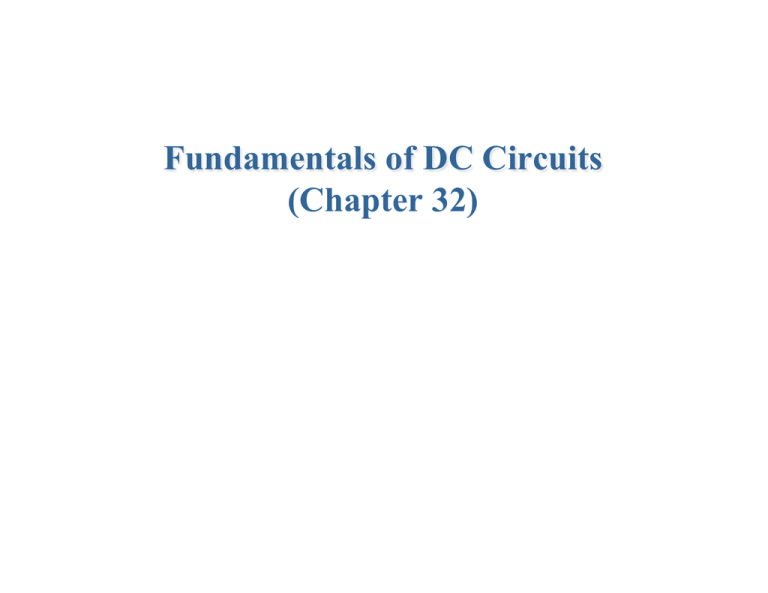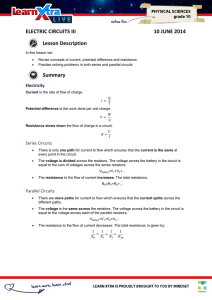Document
advertisement

Fundamentals of DC Circuits (Chapter 32) What types of circuits will we study here? DC CIRCUITS (DIRECT CURRENT CIRCUITS)! • DC circuits have a source of emf (eg. battery) that does not change with time • The current can vary with time but the direction of the current does not change. In Chapter 36 we will learn AC (Alternating Current) Circuits. Alternating currents are created by electrical generators. A circuit diagram is a short hand pictorial representation of the components in a circuit and how they are connected. (In Chapter 36, we will add symbols for inductors and generators) Examples of Circuit Diagram = = 4 Rules for Solving DC Circuits: 1)Kirchoff's Junction Law: !I in = ! I out 2)Kirchoff's Loop Law: "Vclosed #loop = ! "Vi = 0 i 3)Ohm's Law (applies to resistors and light bulbs) "V = IR = R(dQ / dt) 4)The voltage across a capacitor "VC = Q / C Sign Conventions for Kirchoff s Loop Law Batteries: !V = Va " Vb (going uphill ) (going downhill ) Sign Convention for Resistors Moving across the resistor in the direction of current decreases !V = Va " Vb the potential electron s rolling downhill Sign Convention for Capacitors ( uphill like battery) ( downhill ) Analysis of a Simple Circuit 1. Current is the same everywhere (There are no junctions!) 2. Assume the wires are ideal . This means we can ignore their resistance. Solution 0 = !Vloop = !Vbattery + !VR1 + !VR2 0 = " + (#IR1 ) + (#IR2 ) I = " / (R1 + R2 ) I = 0.50A !VR1 = #IR1 = #5.0V !VR2 = #IR2 = #10.0V Simulations.... Energy and Power in Electric Circuits A circuit is essentially a device that transforms energy into different forms starting from chemical energy in a battery. Chemical Energy of Battery Electrical Potential Energy Kinetic Energy of Electrons Thermal Energy (Light Bulbs Get Hot and Glow!) Power Delivered by Battery (EMF Source) The battery raises the potential energy of electrons. Power= rate at which battery transfers energy to electrons !U = Q!Vbattery P= dE (General defn. of power as time rate of change of energy) dt d " dQ % Q!Vbattery = $ !Vbattery ' # dt & dt = I !Vbattery (Power supplied by battery to circuit) Pbattery = Pbattery This is the rate at which chemical energy is transformed into electrical potential energy! Power Dissipated Due to Heating The electric potential energy causes electrons to move downhill . Potential Energy -->Kinetic Energy Kinetic Energy is transformed into heat via collisions (resistance=electron friction ) Kinetic energy obtained from E field made by battery: !K = W = F!x = (qE)d (d=distance between collisions) Kinetic energy transfered to lattice when electron collides with atom: !E collision = !K = qEd Over a distance L, the electron collides N=L/d times !E Thermal = N !Ecollision = qE(Nd) = q!V Power dissipated by resistor/lightbulb: dE dq PR = Thermal = !VR = I !VR dt dt Energy and Power Power is the energy supplied or expended per unit time P=dE/dt. Unit of power is the Watt 1W=1J/s. The power supplied by a battery to a circuit: Psupplied = I!Vbattery The power expended by an Ohmic device (resistor, wire, light bulb): Pexpended = I!VR = I 2 !VR ) ( R= R 2 The power dissipated by two series resistors How much power do each of the resistors dissipate ? != Solution Kirchoff's Law for the Voltage: ! " IR1 " IR2 = 0 ! I= = 0.40A (R1 + R2 ) 2 2 W PR1 = I R1 = 0.4A # 12$ = 1.92W PR2 = I 2 R2 = 0.4A 2 # 18$ = 2.9W Pbattery = 12V ! 0.4A = 4.8W Multiple Resistors: Series vs. Parallel Connections Series: Resistors connected sequentialy. Single closed current loop. Parallel: Each resistor is individually connected to battery Resistors in Series: How to Derive the Equivalent Resistance " !V = 0 i i 0 = Vbattery # IR1 # IR2 # IR3 I(R1 + R2 + R3 ) = Vbattery • Resistors are aligned end to end, with no junctions between them, • The current I is the same through all resistors placed in series. IReq = Vbattery Req = R1 + R2 + R3 (equivalent resistance) Parallel Resistors: How to Derive the Equivalent Resistance I = I1 + I 2 (Kirchoff's Junction Law at junction a OR b) I1 = !V1 / R1 = !Vbattery / R1 The potential differences ΔV are the same across all resistors placed in parallel. I 2 = !V2 / R2 = !Vbattery / R2 I= !Vbattery R1 + !Vbattery R2 = !Vbattery Req " 1 1 1 = + Req R1 R2 " Req = R1 R2 R1 + R2 Summary of Parallel vs. Series An Example of Resistor Network... Solution... A Nontrivial Example: Initial Circuit: Equivalent to this circuit: R/2 resistors are in series Because there are 2 sources of emf, we can t reduce this to a single equivalent resistor ! Is the resistor between a-b in series or parallel ? Solution: Kirchoff s Rules Always Work ! There are two separate closed loops that enclose the segment a-b: Yields a system of three linear equations. At the junctions a and b: I1 = I 2 + I a !b First Loop: !2" ! I1 R ! I a !b R = 0 Second Loop: " + I a !b R = 0 Adding the two loop equations: ! " ! I1 R = 0 Second Loop + Junction Eq.: " = (I 2 ! I1 )R I2 = 0 Comment About the Sign of I: I1 = ! " / R We chose the direction for I1 incorrectly! Kirchoff's Law is "Self-Correcting". If you choose the direction of the current wrongly, the solution will be negative. Real Batteries Real batteries have resistance! This internal resistance is usually small compared to the resistance of the circuits. Typical internal resistances: 1)Akaline batteries (AA, AAA, C, D): 0.15-0.3 Ohms 2)Lead-Acid Car Battery: 0.05 Ohms 3)Lithium Ion (cell phone, laptop): 0.3 Ohms Internal resistance reduces the voltage delivered by battery to circuit: !Vb = " # Ir = " # !Vb = R " R+r r " R+r Example of Internal Resistance What is the voltage of the battery and internal resistance?? Case 1: Switch is open ! I'= = 1.636A r + 5.0" ! = I '(r + 5.0") Solution Case 2: Switch is closed I = I1 + I 2 I1 = 1.565A I 2 = I # I1 Resistors are in parallel---> They have the same voltage I1 (5.0") = 7.825V = (I # I1 )(10") 15" I = I1 = 2.348A 10" Closed Switch- Loop through ammeter ! # Ir # I1 (5.0") = 0 ! = Ir + I1 (5.0") Final Solution... Two equations and two unknowns: ! = I '(r + 5.0") = (1.636A)(r + 5.0") ! = Ir + I1 (5.0") = (2.348A)r + 7.825V Solve.... ! = 9.0V r = 0.50" Electrical Measurements: Ammeters & Voltmeters Ammeters Ammeters measure electric currents I in circuits. They must be placed in series with the device through which the current is to be measured. An analog ammeter (aka galvanometer) measures current by magnetic forces. The current in the wire creates a magnetic field that interacts with the permanent magnets deflecting the needle. Works on same principle as electric motor. Ammeter has a small internal resistance that is usually negligible. Voltmeters 1)A voltmeters is a device used to measure the voltage across a circuit element. 2) It is connected in parallel with the circuit element to be measured. 3)Connecting in parallel yields the same potential difference across the voltmeter and circuit element. What is the ideal resistance of a voltmeter??? Voltmeters (2) An ideal voltmeter has infinite resistance. The equivalent resistance of the voltmeter and resistor is 1 1 1 1 = + ! when Rvoltmeter ! " Req R Rvoltmeter R When Rvoltmeter ! ", the voltmeter doesn't disturb the circuit by drawing any current. Analog voltmeters consist of a very very large resistor in series with a sensitive ammeter An Even More Difficult Example :) All resistors are R and batteries ε. What does the voltmeter and ammeter read? = ??? First Simplification.... R 1 1 1 1 = + = Rab 2R 2R R R Solution (Cont.) Solve like earlier problem. Voltmeter draws no current and Ammeter is assumed ideal. Three Equations for three unknowns (I1, I2,Iab): 1. Current Junction 2. Loop 1 3. Loop 2 Loop 2 Loop 1 I1 I ab I2 Resistor-Capacitor (RC) Circuits: Time Varying Currents. • Resistor and Capacitor are in series. • The resistor restricts the current and prevents capacitor from discharging instantly. • Use Kirchoff s loop law to get a differential equation for the charge in the circuit Case 1: Solving for a Discharging Capacitor !VC " !VR = 0 Q / C " ("IR) = 0 dQ I= dt dQ = "Q / # # =RC dt Q = Q0 e"t /# (Charge on Capacitor) I = I 0 e"t /# (Current through resistor) Case 2: Charging an RC Circuit With a Battery • Initially there is no charge on the capacitor. • Closing the switch connects the RC to the battery allowing current to flow and the capacitor to charge. Case 2: Solving for the Charging of an RC Circuit ! " IR " Q / C = 0 dQ +Q /# = ! / R dt Q(t) = Qmax (1 " e"t /# ) Qmax = ! C Qmax "t /# $ ! ' "t /# I(t) = e =& )e % R( # Example: Energy Dissipated Through Resistor When the switch is flipped from a to b, how much energy is dissipated through the resistor after 1.25ms?? Solution...... The energy dissipated by the resistor equals the change in the energy stored in the capacitor : Q(t = 0) = ! C = (50V )(20 " 10 #6 F) = 1.0 " 10 #3 1 Q 2 1 (1.0 " 10 #3 C)2 U(t = $) = = = 25mJ #6 2 C 2 20 " 10 F Q(t = 1.25ms) = Q(0)e#t / RC = 1.0 " 10 #3 e#1.25 ms /1ms = 0.2865 " 10 #3 C 1 Q 2 1 (0.2865 " 10 #3 C)2 U(t = 1.25ms) = = = 2.05mJ #6 2 C 2 20 " 10 F %ER = U(t = $) # U(t = 1.25ms) = 23mJ








